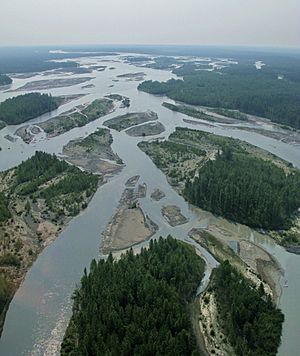Chulitna River (Susitna River tributary) facts for kids
The Chulitna River is a river in interior Alaska. It is about 110 kilometers (68 miles) long. The Chulitna River is a "tributary," which means it's a smaller river that flows into a larger one. It joins the Susitna River near the town of Talkeetna.
Three smaller streams, called "forks," come together to form the Chulitna River. This river then flows into the Susitna River.
Contents
Where is the Chulitna River?
The Chulitna River starts where its Middle and East Forks meet. This spot is in a valley between two big mountain ranges: the Alaska Range and the Talkeetna Mountains. It's also east of Denali, North America's tallest mountain.
The river flows south. It meets the Susitna River at Talkeetna. The Susitna River then flows into the Cook Inlet, which is part of the Pacific Ocean.
Rivers that Join the Chulitna
Many other rivers and creeks flow into the Chulitna River. These are also called tributaries. Some of the bigger ones include:
- West Fork Chulitna River
- Ohio Creek
- Fountain River
- Hidden River
- Coffee River
- Tokositna River
All these rivers join the Chulitna from its right side as it flows south.
How Big is the River's Area?
The area that collects water for the Chulitna River is called its "catchment area." This area is very large, covering about 6,600 square kilometers (2,500 square miles).
The river's average flow near its end is about 250 cubic meters (8,800 cubic feet) of water per second. This is like a huge amount of water moving very fast!
The Chulitna River gets most of its water from melting glaciers. Because of this, the river flows fastest in the summer months, from June to August. This is when the most ice and snow melt.
The River and the Highway
A major road called the George Parks Highway runs right next to the Chulitna River. This highway connects two big Alaskan cities: Anchorage and Fairbanks. So, if you drive on this highway, you'll see the river for a long stretch!
What Does the Name Mean?
The name "Chulitna" comes from the local native people of Alaska. It was first written down in 1898 by a person named G.H. Eldridge.


